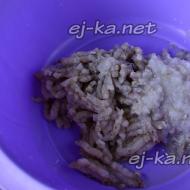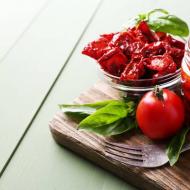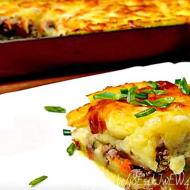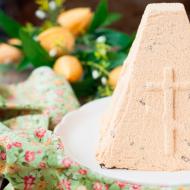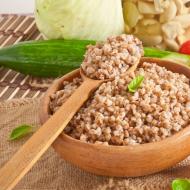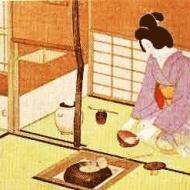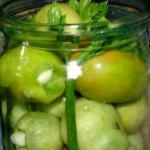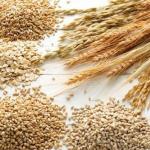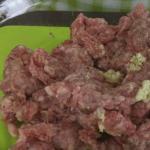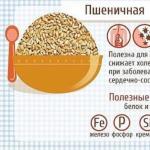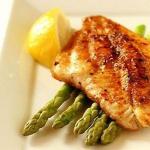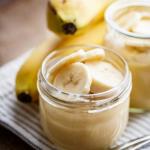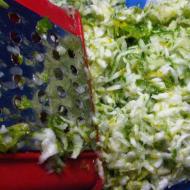
Buckwheat noodles. Soba - noodles made from buckwheat flour Noodles made from buckwheat flour what is it called
Buckwheat is a valuable and important product for those who always adhere to a proper and healthy diet. All dishes prepared with it are rich in vitamins and minerals. This is precisely why buckwheat noodles are so popular, which are quite easy to prepare at home if you have buckwheat flour on hand.
Buckwheat noodles: benefits and how to cook it yourself
Buckwheat noodles are a popular dish in Asia, especially China and Japan, and as you know, these countries are famous for healthy food. These noodles differ from ordinary noodles in that they are made from buckwheat flour or with a small addition of wheat flour.
A very necessary and useful product for the body. Buckwheat noodles are also very healthy. First of all, because it is very easy for the digestive tract, and it also contains a lot of useful vitamins, trace elements and minerals.
The technology for making buckwheat noodles is not that complicated, so it can be prepared at home, but you can also buy it in the store (called “soba”).
To cook delicious buckwheat noodles, you need to know how to do it correctly, because these noodles are very tender and can boil over. To make soba easier to cook, they began to add a small amount of wheat flour to it, then it does not boil so much.
If you want to make your own noodles, you need to know that it will take some physical effort. After all, buckwheat flour is kneaded worse than ordinary wheat flour. But there are benefits from it, what a good exercise for the arms and shoulders.
Buckwheat noodles can be prepared in different ways. It can be served as a side dish, as a first course (noodle soup), added to a salad, made into casseroles, or seasoned with sauce. Also, it is very tasty both hot and chilled.

Soba is an excellent product that is eaten both in winter and summer; it is easy on the body, but adds strength and energy. Buckwheat noodles, like buckwheat, contain: B vitamins, magnesium, calcium, copper, phosphorus, iron and many other useful elements.
Buckwheat noodles do not contain fat and, therefore, you can eat them and not be afraid of gaining weight, unlike ordinary pasta. Especially if the noodles contain only buckwheat flour, and this is an exclusively dietary product.
Recipe for making buckwheat noodles yourself
To prepare buckwheat noodles we will need:
- 0.5 kg buckwheat flour;
- 0.22 kg wheat flour;
- 250ml water (hot).

Well, let's begin. Take a container and pour both buckwheat and wheat flour into it. Mix everything well.
Now add half the hot water and mix our dough. Later add the rest of the water and continue kneading.
Having finished kneading, we divide our dough into several parts, from which we roll into small balls. Now let our koloboks stand for half an hour.
After half an hour, we roll out our koloboks so that the width of the rolled dough is half as long as it is, and the thickness is no more than 3 mm. And so each bun, with each rolled pancake, is placed on top of each other.
Let's move on to the most important stage, you need to very carefully cut thin strips of 3mm. Once you're done cutting, you can safely start cooking or freeze for later.
Now you can safely conquer Japanese cuisine!!!
Buckwheat: benefits and harms
Like many other cereals, buckwheat has many advantages. Doctors advise consuming it regularly. But, oddly enough, there are some factors that do not allow you to eat buckwheat. Although buckwheat is a very healthy product, let’s learn about it in more detail.
They started growing buckwheat on our territory a very long time ago, and even then it was held in high esteem. In general, our ancestors had a positive attitude towards porridge, which is why there are so many proverbs and sayings.
Buckwheat is one of the first in the ranking for beneficial properties. And all because of the high content of microelements, vitamins and minerals necessary for our body. It contains a whole range of useful substances: vitamins B1, B6, B2, B9, vitamin E, iron, copper, phosphorus, iodine and calcium.
But that’s not all, buckwheat is a unique product in that it contains a large amount of vegetable protein, which is well absorbed by the body, but is not stored in fat reserves.
And amino acids, with a special structure, on the contrary, help improve the functioning of the body and metabolism. That is, if you want to lose weight, buckwheat can help you.
Buckwheat contains fiber, which is so necessary for vision. Because of all these beneficial properties, buckwheat is recommended for everyone: children, adults, elderly and sick people. Therefore, buckwheat porridge is often prepared in kindergartens, schools, hospitals, and sanatoriums.
Buckwheat is very useful for many diseases, especially those related to the heart and blood vessels. Buckwheat is also very good as a cereal, because its storage does not require special conditions. Like all cereals, it should be stored in a cool, dark place in a glass jar.
But buckwheat also has, so to speak, “contraindications.” Buckwheat affects blood clotting (cannot be consumed if there is increased blood clotting).
And also its use for some people can affect the stomach, because all people are different and everyone reacts differently to all foods. Some may even develop allergies, but such cases are quite rare.
Buckwheat flour: its benefits
Buckwheat, porridges made from it, casseroles, soups and much more are often found in modern cuisine. And in Asia, just like here today, buckwheat flour is often used. But over time, they somehow forgot about it and began to use only wheat. But buckwheat flour is much healthier.

Buckwheat flour can completely replace wheat flour. You can also use it to make delicious pies, pancakes, pancakes, and even dumplings with dumplings. Buckwheat flour can be found on store shelves, or you can make it yourself.
To do this, you just need to rinse the buckwheat and grind it to the consistency of flour in a food processor. But store-bought and homemade buckwheat flour will be different, because at home you cannot peel the grains from the husk. Although it will be even healthier, the taste will be slightly different.
Therefore, everyone chooses for themselves which flour makes their dishes tastier. But the benefits of flour are significant, no matter how you prepare it. All dishes containing buckwheat help cleanse the body, that is, with regular consumption of buckwheat, all harmful substances are eliminated and metabolism is improved.

Buckwheat is a set of useful components: vegetable protein, fiber, iodine, iron, phosphorus, zinc, copper, vitamins B and E. And the low fat content is useful for those who have problems with excess weight and cholesterol.
All these very beneficial properties of buckwheat are preserved in flour. After all, everyone knows that it is impossible to eat buckwheat porridge alone, but if it is so healthy, then you can eat it differently each time.
Buckwheat flour has only one drawback - it is not very easy to knead dough. To make it easier to cope with this task, you can add wheat flour to buckwheat flour, or entrust this task to a bread machine, which will knead the dough for you.
You may have to tinker a little with the dough, but you will get a tasty and healthy dish for your health!
Features of buckwheat noodles, production methods. Calorie content and nutrients in the composition. Health effects and restrictions on use. Recipes for dishes with noodles and interesting facts about it.
Buckwheat noodles are a pasta product in the form of thin strips, in the production of which buckwheat flour was used (at least 30% of the total composition). The color is brownish-gray, of varying intensity, largely depending on the additional ingredients. Initial raw materials - 2-3 types of flour. This is explained by the fact that there is no gluten in the grinding of buckwheat grains, since the plant does not belong to the Cereal family. The product gained popularity at the beginning of the twentieth century, first in Japan, then in Eastern countries. The fashion for this type of pasta came to Europe in the sixties, when they began to actively popularize a healthy lifestyle.
Features of making buckwheat noodles

The technology for making this product is still kept secret by the Japanese. Despite the lack of gluten, they learned how to make thin noodles from ground buckwheat with a small amount of gelling additive. This product is called nihon-soba. And classic Japanese buckwheat soba noodles are made from buckwheat (at least 30%) and rice flour.
To increase the plasticity of the final raw material, buckwheat grains are brought to a moisture content of 25-30%, soaking in sealed containers for 2-3 hours. This process is called defoliation. Then heat treatment is carried out using the conductive-convective method (blowing) at a temperature of 160-190°C in special installations. The process is short-term, duration - up to 3 minutes.
The prepared raw materials are ground, dried and combined with rice flour in a 2:1 ratio, diluted with boiling water and layers of dough are applied to the fabric. They are dried using directed blowing, cut into thin strips and dried in finished form.
To increase the plasticity of the mixture when preparing buckwheat noodles, starchy or gelling compounds can be introduced. Chinese pasta factories often use additives for the same purpose: unfermented green tea, ground pumpkin seeds, soy, nut mixtures.
A product made only from buckwheat or with the addition of a small amount of rice is not cheap, so you can often find vermicelli, in which only a third of the main ingredient is, and the rest is wheat or rye flour.
How to cook buckwheat noodles at home:
- With wheat flour. Fried buckwheat is washed and thoroughly dried. Grind using a coffee grinder or hand mill. Knead the dough from 1.5 cups of buckwheat and 2.5 cups of wheat flour, beating in one yolk and adding hot water as needed. Add a little salt. Thick elastic dough is wrapped in food grade polyethylene and allowed to stand for 30 minutes. It is then put through a spaghetti machine, first forming into a sheet and then cutting into individual strips. If you don’t have a similar attachment for a food processor, roll out the dough by hand and cut it into noodles. Do not fold the dough into several layers, as it may break. Dry the product, spread out in one layer, in the sun or in the oven with the door open at a temperature of 40°C.
- With rice flour. In this case, the ingredients are combined in the following proportion: 2 parts buckwheat flour and 1 part rice flour. They sift everything, beat in chicken eggs - “by eye”, and dilute the mixture with boiling water. If you cannot get an elastic dough, roll it out several times into a layer, sprinkle with finely ground wheat flour and mix again. When it is possible to obtain a non-brittle, elastic dough, it is rolled out in a thin layer, cut and dried, as already described. To prevent individual strips from sticking together, you can sprinkle them with rice flour.
At home, you can prepare buckwheat noodles as usual, experimenting with additives and the amount of other ingredients. With sufficiently long hand kneading, you can make almost transparent short noodles using 3 parts buckwheat flour and 1 part high-gluten wheat flour.
In this case, first mix the dry mixture, rubbing it thoroughly between your fingers, and then pour everything into the bowl of the food processor and stir, adding boiling water in a thin stream. While the dough is hot, it is passed through the rolling attachment and then cut into spaghetti mode. If the dough cools down, it will begin to break. For gluing, you can add protein. When drying, the noodles are sprinkled with finely ground rice flour.
Composition and calorie content of buckwheat noodles

The nutritional value of real Japanese nihon-soba, the recipe for which Europeans were never able to figure out, is only 278 kcal per 100 g.
The calorie content of buckwheat noodles made with wheat (rice and sometimes rye) flour is 348 kcal per 100 g, of which:
- Proteins - 15 g;
- Fats - 1 g;
- Carbohydrates - 71 g;
- Dietary fiber - 10 g;
- Ash - 2.54 g;
- Water - 11.15 g.
Vitamins per 100 g:
- Lutein + Zeaxanthin - 220 mcg;
- Vitamin B1, thiamine - 0.417 mg;
- Vitamin B2, riboflavin - 0.19 mg;
- Vitamin B4, choline - 54.2 mg;
- Vitamin B5, pantothenic acid - 0.44 mg;
- Vitamin B6, pyridoxine - 0.582 mg;
- Vitamin B9, folate - 54 mcg;
- Vitamin E, alpha tocopherol - 0.32 mg;
- Gamma Tocopherol - 7.14 mg;
- Delta Tocopherol - 0.45 mg;
- Vitamin K, phylloquinone - 7 mcg;
- Vitamin PP - 6.15 mg.
Macroelements per 100 g:
- Potassium, K - 577 mg;
- Calcium, Ca - 41 mg;
- Magnesium, Mg - 251 mg;
- Sodium, Na - 11 mg;
- Phosphorus, P - 337 mg.
Microelements per 100 g:
- Iron, Fe - 4.06 mg;
- Manganese, Mn - 2.03 mg;
- Copper, Cu - 515 μg;
- Selenium, Se - 5.7 μg;
- Zinc, Zn - 3.12 mg.
Digestible carbohydrates per 100 g:
- Mono- and disaccharides (sugars) - 2.6 g;
- Sucrose - 1.7 g.
Buckwheat noodles contain:
- Essential amino acids - 10 names;
- Replaceable amino acids - 8 types;
- Fatty acids - omega-3 and omega-6;
- Saturated fatty acids - 6 types;
- Monounsaturated fatty acids - palmitoleic, oleic and erucic;
- Polyunsaturated fatty acids - linoleic and linolenic.
The calorie content of boiled buckwheat noodles is significantly reduced - to 99-109 kcal per 100 g.
As the product swells, it becomes lighter. The standard serving for an adult is 200-250 g. So those losing weight can safely include the dish in their daily menu: the nutritional value, taking into account a small amount of olive oil, is no more than 220 kcal.
Beneficial properties of buckwheat noodles

The most useful product for weight loss is green vermicelli. It contains green tea as an additional ingredient. It contains much more useful substances, a pronounced diuretic effect due to the additive. Weight loss is much faster.
Benefits of buckwheat noodles:
- Normalizes blood pressure. Green vermicelli is especially useful for hypertensive patients.
- Helps quickly build muscle mass.
- Increases hemoglobin levels.
- Has an antioxidant effect. Due to the high content of useful substances, it isolates free radicals circulating in the lumen of blood vessels.
- Accelerates metabolic processes, allowing you to quickly recover after physical activity.
- Stabilizes the functioning of the nervous system and allows you to cope with the consequences of stress in a short time.
- Brings you back to sleep quickly.
- Increases potency.
- Strengthens the myocardium and stabilizes the functioning of the cardiovascular system.
There are no contraindications for inclusion in the diet for pregnant women, young children and the elderly. Additional additives improve the quality of the main product.
Contraindications and harm of buckwheat noodles

If you have a history of celiac disease, you need to carefully read what is written on the package. Only very expensive pasta made in Japan is gluten-free. All other products contain gluten. If buckwheat noodles contain rice flour (it contains a minimal amount of gluten), and celiac disease occurs without severe symptoms, introducing it into the diet in small quantities is acceptable.
Buckwheat noodles cause harm if you are allergic to any ingredient in the composition and if abused by people with hypersensitivity of the digestive tract.
In case of exacerbation of peptic ulcer disease, erosive gastritis and chronic diarrhea, it is better to stop using it.
Recipes for dishes with buckwheat noodles

When experimenting with culinary recipes, you should keep in mind that after eating a dietary product, a nutty aftertaste remains. This is reflected in the culinary qualities of the dishes. Therefore, the choice of spices should be approached with caution.
Without knowing how to cook buckwheat noodles, you can ruin the main dish. Unlike rice, it requires boiling. If you do not bring it to readiness, you will feel heaviness in the stomach; if you overdo it, the dark stripes will stick together and the dish will look unappetizing.
It is recommended to cook regular noodles with rice or wheat flour for 10 minutes, with green tea - 12-14.
To get a more pronounced taste, it is recommended to add vegetable oil. The proportions of water and dry product are better than 10:1, that is, 100 g of noodles per 1 liter of water. If the recipe says “bring the pasta until half cooked,” then you need to transfer the vermicelli to a colander, rinse with cool water, and only then simmer or finish cooking.
Recipes with buckwheat noodles:
- Casserole. Pieces of boiled meat, 200-250 g, finely chopped. The broth is not drained. Boil the pasta and allow excess liquid to drain. Fry chopped onions (1 onion) in a frying pan until golden brown. Remove the onion and simmer 200 g of spinach in butter in the same bowl. The oven is heated to 180°C, the silicone deep mold is greased with butter. Lay out the ingredients in layers, like a cake, alternating noodles, onions, meat, spinach. Beat 2 eggs with 700 ml of meat broth, pour into the casserole, and place in the oven. Cooking time: 20 minutes. The casserole is served with soy or tomato sauce.
- Buckwheat noodle soup. You need to cook a rich chicken broth; to prepare the dish in the future you will need 200 g of chicken breast and 300 ml of liquid, an egg, also boil the pasta separately - 80 g. The fillet is cut into portions and fried in soy sauce, sesame seeds, red and black pepper. Place noodles, chopped egg, and meat into the hot broth. The soup is salted and seasoned with soy sauce to taste. Please note: all ingredients are prepared separately.
- . Noodles, 1-2 standard bunches, are boiled, placed in a colander, and then placed on plates. Heat sesame oil in a frying pan and add 3-4 cloves of garlic. Peeled shrimp are cooked in flavored oil to obtain a golden crust. Add them to the noodles. Next, fry in turn: 100 g of champignons, zucchini cut into small pieces, grated carrots, sweet pepper ribbons. Everything is laid out beautifully on a platter, poured with soy sauce, and sprinkled with sesame seeds. You can replace the shrimp with a sea cocktail, add octopus or mussels to it.
- Buckwheat noodles with vegetables. To prepare the dish, you need a Korean vegetable grater and a deep frying pan, preferably a wok. Boil vermicelli according to the method already described. Prepare vegetables: eggplant, carrots, zucchini, large bell peppers - red and yellow, red Yalta onion or 2 leeks. Chop a few garlic cloves. The leek stem is cut lengthwise. Vegetables, starting with garlic, are fried in hot butter, sprinkled with sesame seeds. Without draining the oil with the garlic-vegetable aroma, lay out the noodles, vegetables, and pour over a mixture of sauces - oyster and soy. Leave on fire for 3 minutes, stirring constantly. The hot dish is served in deep plates or bowls. Salt, pepper and herbs are added to taste and desire. For those losing weight, it is better to do without salt, especially since soy sauce gives it a salty taste.
- Buckwheat noodles with chicken. Chicken meat, 200 g, cut along the grain, left to marinate in soy sauce with garlic. Boil the noodles separately. Heat a frying pan, fry the meat in vegetable oil until cooked, add boiled buckwheat vermicelli and, stirring thoroughly, simmer in teriyaki sauce for 3 minutes. The dish is tasty and low in calories. Often other ingredients are added to the recipe, for example, vegetables - carrots, tomatoes, bell peppers. The same dish is often prepared with pork. In this case it is called yakisoba.

This product gained its popularity among the Asian population due to the fact that after consumption a person felt full for a long time. These countries have very strong traditions, and one of them is moderation in food.
If in Rus' it has long been believed that eating little means offending your hosts, then in Japan and China, on the contrary, moderation in food during a long conversation was a sign of respect. Therefore, the small dish, which suppresses the feeling of hunger for a long time, was immediately appreciated.
However, housewives still prefer rice noodles. It is more neutral and goes well with almost all seasonings and sauces. Buckwheat has a distinct taste. Buckwheat replaced rice only during lean seasons.
Types of pasta with buckwheat:
- Soba - with the addition of rice flour;
- Nihon-soba - with wheat flour;
- Tyukasoba - with eggs, Chinese noodles.
Acceptable additives to buckwheat flour when making noodles: wheat, rye or oatmeal, seaweed, green tea, corn starch.
The qualifications of a Japanese restaurant chef can be judged by the preparation of buckwheat noodles. It is served with tempura or in soups. If you have prepared a casserole, a dish with vegetables or meat, as described above, you can conclude that the cook is European and cross off the address of the establishment from the list of Japanese or Chinese restaurants.
How to cook buckwheat noodles - watch the video:
At home, you can experiment endlessly with buckwheat noodles. According to reviews from those losing weight, it is worth replacing regular pasta with buckwheat, and you can forget about the feeling of hunger during the diet. For those who have to control their own weight, buckwheat noodles are an ideal choice.

According to experts in the history and culture of Japan, pasta made from buckwheat flour appeared on the tables of residents of this Far Eastern state relatively recently - perhaps in the 17th century. However, they quickly gained enormous popularity and today are one of the flagship products associated with Japanese cuisine. Residents of Tokyo, Osaka and Yokohama eat buckwheat pasta in a variety of situations, warm and cold.
On almost every Japanese street there is a restaurant serving dishes made from brownish-gray threads with a distinctive, slightly nutty taste. They are offered in both cheap bars and elite restaurants. Locals love soba for its taste, but also believe that its threads symbolize long life. However, this product can really have a beneficial effect on health, because buckwheat flour has impressive nutritional properties.
Advantages of buckwheat

The basis of soba pasta is dark flour made from ground buckwheat grains. It is a very rich source of valuable minerals, especially magnesium (helps reduce stress levels, restore mental balance, calms nerves) and iron (responsible for transporting oxygen to red blood cells, binds carbon dioxide and sends it to the lungs, from where it is removed. The effectiveness of these two processes determines our performance - both physical and intellectual).
Buckwheat flour also supplies the body with a lot of fiber, which regulates digestion, helps cleanse the intestines of harmful substances, thereby protecting, in particular, from constipation.

Thanks to the main component of soba pasta, we also enrich the body with a significant amount of folic acid. This vitamin is especially needed by pregnant women for the normal development of the fetal nervous system. And antioxidants protect against free radicals, which are responsible for the aging of the nervous, cardiovascular system and skin.
Buckwheat flour is one of the richest natural sources of rutin, a substance very important for blood vessels. Thanks to this, soba pasta prevents the development of varicose veins.
Buckwheat products also supply the body with valuable amino acids, in particular lysine. It is indispensable for muscles and bones, improves concentration, mental performance, participates in the production of hormones, antibodies, enzymes, and alleviates the symptoms of infection. They also contain methionine, which helps detoxify the body and cleanse it of toxins.
How to eat soba pasta

Soba can be recommended for people suffering from gluten intolerance: buckwheat grains do not contain it. However, the problem is that it is difficult to buy pasta made exclusively from buckwheat flour. As a rule, the majority of their composition is made of wheat flour, which is not recommended for people following a gluten-free diet. Therefore, it is always worth checking the composition of the product.
Cooking soba is not difficult. The pasta is placed in boiling water seasoned with a pinch of salt or a tablespoon of soy sauce, and after 3-5 minutes the Japanese delicacy is ready to eat. However, before serving, it should be rinsed with cold water, rubbing with your hands to remove the layer of starch remaining after cooking.
There are many ways to use soba in your diet. The simplest is to replace traditional wheat pasta with it, for example, adding it to the broth. However, you need to keep in mind that this product may slightly adjust the usual taste of food.

Usually oriental dishes are prepared with such pasta. In Japan, soba is used primarily in various soups, usually based on kombu seaweed broth.
The pasta can be combined with various additions, such as fried tofu or wakame seaweed, which can be purchased in online stores without any problems. Soba is suitable for stir-fry dishes fried in very hot oil (preferably sesame oil).
They can be combined with pork, poultry, fish or seafood (especially shrimp) and vegetables: radishes, white onions, shallots, carrots, sun-dried tomatoes. Soba is also good with spices - sesame seeds, coriander seeds fried in a frying pan, and also with ginger. Buckwheat pasta can also be eaten cold, flavored with dip. In Japan, it is usually made with mirin wine, dashi stock, and soy sauce.
Soba noodles are the national Japanese noodles made from buckwheat or wheat flour. The noodles are easily comparable in thickness to spaghetti and can be served hot or cold.
The amazing nutty flavor of soba noodles goes perfectly with French fries and a variety of salads. While soba noodles are rich in nutrients.
Many people's favorite dish is prepared quite easily and simply. The main thing is to read the article carefully and learn about the secrets of preparing a unique Japanese dish.
Noodles are most often served at the table:
- with chilled without broth;
- with tsuyu sauce in a special cup;
- sometimes with hot broth as a noodle soup.
Benefits and harms
Many Japanese consider Soba noodles to be the secret to slimness and longevity. Representatives of eastern peoples usually prepare the dish using buckwheat flour. Thanks to this dish, they get more protein, which is very important for a healthy body.
Residents of Japan and China refuse to eat sweets. Buckwheat flour is the base for Soba noodles and has many health benefits. According to experts, Soba is the healthiest noodle than classic noodles.
Each person can cook their own noodles. In this case, you will need to use sifted buckwheat flour or buckwheat ground into flour.
During the process of kneading the dough, 1/3 of the amount of buckwheat is added. To make the dish, you must use wheat flour, otherwise the dough will not knead.
Many Chinese use a lot of seaweed or a certain amount of green tea in their noodles. The energy value of Chinese noodles per 100 grams is 330 kcal.
Composition of buckwheat noodles
Soba is produced in China. Basically, noodles are produced in packaging with a net weight of no more than 300 grams. This unique product is valued for its absence of preservatives, dyes and GMOs.
Before presenting the product to the whole world, experts conducted numerous studies and observations. These noodles comply with GMP and HACCP standards.
The nutritional value per hundred grams is as follows:
- cholesterol – 0 g;
- fats – 1 g;
- carbohydrates – 40 g;
- proteins – 7 g;
- sodium – 75 mg;
- fiber – 0 g;
- sugar – 2 g;
- calcium – 2%;
- iron – 4%.
Sauce
Soy sauce is widely used to prepare Japanese dishes. However, it all depends on the preferences of the owners.
It should be noted that soy sauce is a major component of Asian cuisine. The thin, dark-colored sauce contains saturated fats and acids.
No less popular is tsuyu sauce, which is used in Japanese cuisine to prepare soba noodles. This product has a great taste and is served when the noodles are cold.
 Photo: tsuyu sauce for soba noodles
Photo: tsuyu sauce for soba noodles
This delicious Japanese invention has a different name (Mentsuyu). You can make your own salad dressing or complex sauce at home.
To do this you will need to stock up on the following ingredients:
- light soy sauce – (1 tbsp);
- Mirin seasoning sauce – (20 ml);
- Hondashi broth in granules - (½ tsp);
- white fried sesame seeds – (1 tsp);
- hot water – 100 ml.
Using traditional seasonings, you can prepare a delicious sauce:
- Initially, you need to prepare the Dashi broth and at the same time dissolve the Handashi granules.
- Then add mirin and light soy sauce to a small saucepan.
- By mixing the mixture with the broth, you need to get liquid. The fire should be medium.
- As soon as the liquid boils, you need to pour the prepared mass into a container, let it cool and only then place it in the refrigerator.
The sauce is served cold.
Variety of preparations of Soba noodles
Gourmets consider the product to be very versatile and also healthy. A hot or cold dish is served both on holiday and on an ordinary day. Making the side dish the main one, the Japanese and Chinese complement the table with a variety of salads and soups.
Basically, cook and fry, and also serve the dish with sauce and seafood. The most appetizing and delicious noodles are considered to be cooked without a specific additive.
One important point must be taken into account. During the preparation of the dough, the noodles turn out to be quite fragile. Accordingly, it requires special care in preparation.
The thin and long straw of the noodles has a gray-brown tint and a soft, wonderful taste. The cooking process is carried out in a different way than when making classic pasta.
Soba noodles can be made fairly quickly. If, after boiling the soba, you plan to fry it with other products, then no more than one minute is allocated for cooking.
In addition, if you plan to serve soba with vegetables or meat, you can boil it in meat, chicken or vegetable broth. After completion of the process, a tasty and pleasant aroma is obtained.
To preserve soba, you should prepare a clean and dry container. It should be noted that sprinkled wheat flour is stored for a week. Typically, buckwheat and wheat flour are used to make noodles.
But in rare cases, gourmets use soy or rice. This type of flour is less used in China. However, once made, these noodles can be stored for three to four weeks.
Can I use it while on a diet?
Some people who are on diets partly consume Soba noodles. To get rid of extra pounds, leading nutritionists recommend using this product in your diet.
Doctors believe that noodles help reduce body fat, normalize digestion and lower cholesterol levels. Usually, people buy Soba noodles from the store.
If you don’t have enough time and the noodles are purchased, then you should read the instructions for preparing them. Since factory-produced soba may contain additives in the form of algae or corn starch.
Naturally, the cooking time for noodles changes dramatically. In fact, real noodles should be crispy. To obtain such a mass, you should fry it thoroughly using oil. Crispy noodles are served as a side dish or snack with beer.
Price
The approximate cost of the product is presented in the table:
Step-by-step recipes for cooking at home
I would like to present to your attention several noodle recipes with various ingredients.
With vegetables
To prepare noodles with vegetables, you need to prepare the appropriate ingredients.
 Photo: soba noodles with vegetables
Photo: soba noodles with vegetables
Initially you should purchase:
- one package of Soba noodles;
- 1 PC. carrots;
- peanut;
- soy sauce (2 tablespoons);
- ginger (20 g);
- green onions (three branches);
- mushrooms (300 gr);
- rice vinegar (2 tablespoons);
- garlic (two cloves);
- sesame oil (five teaspoons).
Preparation:
- First, you should thoroughly chop the onion, garlic, ginger and then mix together.
- The resulting mass should be fried in a frying pan using congee oil.
- It is advisable to cut mushrooms and carrots into strips.
- The finished ingredients should be added to the mass in a frying pan and fry again.
- Meanwhile, the noodles are cooked for seven minutes.
- The fire must be extremely slow.
- Then you need to drain the water.
The next step involves adding soy sauce and vinegar to the sesame oil. All these ingredients must be mixed thoroughly with each other. After cooking is complete, the dish should be garnished with peanuts and cilantro.
Soba noodles will pleasantly surprise guests who are looking forward to new dishes from the hosts. It is important to note that the amount of ingredients provided is for just one serving.
The calorie content of the dish is 348.45 kcal.
With chicken and vegetables in teriyaki sauce
 Photo: soba with chicken and vegetables in teriyaki sauce
Photo: soba with chicken and vegetables in teriyaki sauce
To prepare this amazing dish, you will need the following ingredients:
- one package of SOBA Noodles (preferably 100 g);
- green onions (1 branch);
- garlic (2 cloves);
- fresh or dried ginger (1 teaspoon);
- soy sauce (1 or 2 tablespoons);
- chicken fillet (500 g);
- sesame oil (2 tablespoons);
- olive or sunflower oil.
This Asian dish is quite easy and simple to prepare. The dish is quite expensive, but it is worth it, since the exquisite aroma of the dish will pleasantly surprise not only the guests, but also the cook himself.
Preparation:
- So, initially you should cut the chicken fillet and place a certain number of small pieces in the pan.
- The chicken should be thoroughly fried in a frying pan with butter or olive oil.
- Next, the finished chicken pieces should be placed on a plate.
- The next stage of preparing the dish is boiling the soba. Add a little salt to the water and cook the noodles over low heat for no more than ten minutes.
- After the cooking process is completed, the noodles should be rinsed in a colander.
- Then, you need to peel the carrots, peppers, onions and cut into beautiful small pieces.
- Carrots and onions should be placed in a frying pan and fried using olive oil. If you don't have olive oil, then you can use vegetable oil.
- After frying this mass, you need to add chopped pepper on top. After mixing the ingredients in a frying pan, add the soba and chicken fillet.
- All components should be thoroughly mixed together. If desired, add a small amount of soy sauce and rice vinegar.
- The dish is stewed under the lid for five minutes.
The finished dish can be served to family and friends.
The calorie content of noodles is 320.7 kcal.
Video: SOBA NOODLES WITH VEGETABLES AND CHICKEN BREAST (Soba noodles with vegetables and chicken)
With pork
As it became known, soba is prepared from various ingredients. To feel the aroma of a unique dish, you should use your imagination and try several interesting recipes.
 Photo: soba noodles with pork
Photo: soba noodles with pork
To prepare this Japanese dish you will need the following ingredients:
- one package of noodles;
- green and red bell pepper (40 g);
- one clove garlic;
- salt to taste;
- carrots (20 g);
- fresh cucumbers (50 g);
- pork neck (80 g);
- onion or red (20 g);
- sauce (50 g);
- Oyster mushrooms (30 gr);
- bamboo shoots (20 g);
- black pepper to taste.
Preparing this dish does not take too much time. It should be noted that Soba noodles are considered an expensive Japanese dish that is made with pork. Basically, the dish is served both for lunch and dinner. Healthy and nutritious foods add incredible flavor.
Cooking method:
- To prepare the dish according to the recipe, you need to boil the noodles in boiling water for five minutes.
- Then, you should defrost the pork, wash it thoroughly, dry it and cut it into thin strips.
- Oyster mushrooms need to be disassembled into thin pieces.
- Finely chopped garlic should be added to the mixture along with onions and peppers. It is advisable to cut all these ingredients into thin pieces.8
- You need to add a little vegetable oil to the frying pan and add chopped garlic and pork inside.
- The mass must be fried for four minutes. Then you should add some carrots, onions, peppers, mushrooms and bamboo shoots (canned). The mass needs to be well fried.
- After completing the steps, you will need to add noodles and Tonkatsu vegetable sauce. All that remains is to fry the meat and noodles with some vegetables. The process lasts for several minutes.
- Cooks often use green onions or cucumber shavings to decorate dishes.
The calorie content of this dish is 106.8 kcal.
Video: Buckwheat noodles (soba) with pork.
With beef and vegetables
Cooking noodles with beef and vegetables is a real pleasure for cooks. An exquisite and unique dish has an incredible taste. Nutrients that pair perfectly with beef provide a delicious flavor.
 Photo: soba with beef and vegetables
Photo: soba with beef and vegetables
Therefore, every housewife should write down the recipe to prepare an amazing Japanese dish.
To prepare soba with vegetables and beef you will need to have:
- carrots (1 pc.);
- vegetable oil;
- bell pepper (2 pcs.);
- garlic (2 or 3 cloves);
- green beans (200 g);
- chili pepper (1 pc.);
- beef (300 g);
- buckwheat noodles (1 pack).
Cooking procedure:
- Initially, the meat should be thoroughly cleaned of the film and cut into small pieces.
- After which you need to marinate in any marinade.
- The garlic needs to be peeled and cut into small slices. And the pepper should turn into thin strips.
- In order to chop carrots, it is recommended to use a special grater.
- You can cook the noodles for three to five minutes according to the instructions on the package.
- Place two tablespoons of vegetable oil in a frying pan, add garlic on top and fry for a few minutes.
- After the mass is completely fried, raise the heat and place the meat.
- As soon as the meat is ready, remove it from the pan and place it on a plate. Z
- Then, you will have to add a little vegetable oil again to fry the carrots, peppers and onions.
- In the process of frying these ingredients, add green beans and a little pepper to your own taste. You should also add salt and pepper while frying the ingredients again.
- Once the process is complete, add the meat to the pan and serve with noodles.
The calorie content of Soba is 135 kcal.
Video: Mr. Wok – Soba with beef in chili sauce
With champignons
In fact, many of our compatriots love dishes with champignons. To add variety to the menu, every housewife should learn how to cook soba with champignons. The method of preparing Japanese dishes is very simple and easy.
 Photo: soba noodles with mushrooms
Photo: soba noodles with mushrooms
Initially, you should prepare the following products:
- soba noodles (one package);
- sesame (1 tbsp);
- sunflower oil;
- vinegar (1 tbsp);
- fresh champignons (200 g);
- large carrots (one piece) 4
- soy sauce (3 tablespoons);
- natural honey (1 tsp);
- leek (5 g).
The aromatic dish is prepared within a few minutes.
Preparation:
- Before you start cooking soba, you need to beautifully cut all the ingredients into a thin layer.
- Then, place the mass in a frying pan and fry for several minutes. Heat treatment is carried out quite quickly.
- After this, you should wash and dry the carrots and champignons, then cut them into thin strips and start frying.
- Meanwhile, place the noodles in a deep container and cook for five minutes.
- During this period, you should not forget about the sauce to add to the mass. Mix the following ingredients in one bowl:
- soy sauce;
- rice vinegar.
- Initially, you need to fry the carrots in a frying pan, then add other ingredients.
- This entire mass should be fried for four minutes. After the carrots are fried and placed on a plate, you need to add the champignons to the pan.
- To cook mushrooms, increase the heat. The process of frying the champignons takes five minutes.
- Once the process is complete, you should add carrots and other ingredients to the mushrooms.
You can serve the dish with sesame seeds. It is advisable to fry the sesame seeds a little in a frying pan.
The calorie content of the dish is 59.1 kcal.
Video: SPICY BUCKWHEAT SOBA NOODLES WITH BROCCOLI AND MUSHROOMS | Vegan recipe 2/4
With shrimp and other seafood
Having tried soba in a restaurant or with friends, it is impossible to forget about the amazing aroma of the Japanese dish. To enjoy the taste of delicious noodles, you only need to read the recipe. Soba is prepared in various ways.
 Photo: soba noodles with shrimp and other seafood
Photo: soba noodles with shrimp and other seafood
Cooks experiment and add ingredients by combining them with different products. This time you can cook soba with seafood or shrimp. The amount of ingredients depends on the serving.
But first you need to prepare the following products:
- buckwheat noodles (2 packs);
- peeled king prawns (400 g);
- soy sauce;
- champignons (100 g);
- garlic (2 or 3 cloves);
- sesame;
- teriyaki sauce;
- one large carrot;
- red bell pepper (one piece);
- olive oil;
- zucchini (one small).
Cooking process:
- To cook shrimp, pour boiled water into a saucepan and place over high heat.
- You can add dried basil or lemon to the water.
- As soon as it boils, the water should be drained and the broth should be allowed to cool slightly. then you should add a little teriyaki sauce.
- At this time, you need to boil several bunches of soba noodles and cook for five minutes.
- In the meantime, you need to chop a certain amount of carrots, zucchini, mushrooms and peppers.
- All these ingredients should be simmered and then king prawns should be added on top.
- After frying the mass in sunflower oil for five minutes, you need to add the noodles in finished form.
The calorie content of the dish is 88.2 kcal.
Video: Soba noodles with shrimp in spicy-sweet sauce
Video: Soba noodles with sea cocktail
We all know that there are countries on our planet that are distinguished by their wise culture, longevity and unusual traditions. This includes Japan, which we can talk about for a very long time, because the country’s culture is extraordinarily beautiful, unusual, filled with special meaning, and here living to a hundred years or more is rather the norm than a surprising exception. Scientists have long proven that the secret of the longevity of the Japanese lies partly in their diet, which contains fish, rice, good teas and buckwheat noodles, which we will get acquainted with today.
Who among us doesn't love noodles? There are none, we make a side dish out of it, cook delicious soups, but for us the product is a product made from wheat flour, with the taste of traditional pasta dishes. You can buy ready-made noodles and make them yourself; the Japanese do the same thing, only the component of the product is buckwheat flour. The result is a very tasty, unusual dish, unusual for us, but no less healthy.
Buckwheat noodles among the Japanese are soba, which is included in the traditional diet of the population. What is its benefit, let's find out further.
For information! You can buy soba in our country in various stores; its color differs from our traditional products; the shade of the noodles is similar to the color of river sand. Typically, the product has a short shelf life, which can be increased by additional components in the composition.
Buckwheat noodles - let's talk about the benefits and harm
Soba and its positive effects
The Japanese are very scrupulous when choosing food, because it is clear that it affects our life, energy, and health. In their diet you can rarely find dishes that do not provide some benefit, and soba is no exception. Eating noodles in your diet can give you the following positive effects:- buckwheat noodles are made on the basis of buckwheat flour, which you can make yourself, the product ultimately contains many vitamins and minerals, which has a beneficial effect on health and immunity;
- Dogs are great for helping improve the functioning of the gastrointestinal tract;
- although the product is high in calories, you can lose weight by consuming it;
- noodles have a beneficial effect on male strength;
- helps hypertensive patients;
- the beneficial properties of buckwheat soba noodles are that it lowers blood cholesterol levels;
- By consuming the product 2-3 times a week, you can normalize your metabolism, which will have a positive effect on weight loss;
- noodles are low in fat;
- fiber in the composition improves the functioning of the digestive and excretory systems, helps to lose weight, cleanse the body of toxins and waste;
- Buckwheat noodles in your diet will have a beneficial effect on your appearance.
The soba is prepared in a special way - careful, gentle processing leaves the product with a maximum of vitamins and nutrients. There is potassium, calcium, selenium, iron, phosphorus, copper, sodium and manganese. There are B vitamins, as well as A, E, PP. The calorie content of soba is 348 kcal. As you can see, a lot, but you can still lose weight by eating the dish due to the fact that metabolism is normalized and digestion is improved.
This is interesting! Noodles made from buckwheat flour may also contain other ingredients, including green tea. This is one of the signs of a good product, so don't be surprised if you read the ingredients on the package. But if there is also wheat flour, then the dish will be higher in calories, but it will be easier to cook.
Harm from eating buckwheat noodles
As we have already said, frequent consumption of the dish can cause weight gain due to its high calorie content, so it is better to always eat soba with plenty of vegetables, no more than 4 times a week, if you want to lose weight. There are no contraindications, except for individual intolerance to the components.
If you have never purchased or eaten this product before, you may be disappointed the first time. But this is all due to ignorance, and then we advise you to read some subtleties that will tell you how to prepare buckwheat noodles, please your family and surprise your guests.
- Soba cooks very quickly and breaks easily, which is why wheat flour is sometimes added to the composition, so you can’t cook noodles as you usually do with pasta.
- You can cook soba in meat broth, which will make it even more tasty and aromatic.
- Buckwheat noodles can be eaten cold or hot, as a side dish, and as an addition to various dishes.
- The noodles are cooked very quickly; if they are then used to prepare various dishes, it only takes half a minute.
- The most delicious buckwheat noodle recipes are those with vegetables. The dish is prepared with onions, carrots, spices, herbs, tomatoes, eggplants and cucumbers.
- Soba is stored for very little time - a maximum of a week, for which it is sprinkled with flour. If the composition contains additives, the timing may increase, so always look at what the manufacturer writes.
- The cooking time may also change if the composition contains starch or algae, so again, always read what exactly this soba production company advises.
- Buckwheat noodles can be served as an appetizer with a foamy drink if you simply fry them in oil.
So, it's time to prepare delicious dishes.
Buckwheat noodles - the best recipes for the whole family
Soba with chicken
We will need:
- noodles – 200 grams;
- tomatoes - two medium ones;
- garlic cloves – 3 pieces;
- chicken meat - fillet is best - 350 grams;
- mushrooms - to your taste, you can take champignons - 200 grams;
- celery - two plant stems;
- sauce - traditionally added to Teriyaki buckwheat noodles, but you can replace it with your favorite one or the one you have on sale. You will need 2-3 tablespoons;
- oil for frying.
Let’s immediately answer the question of how long to cook buckwheat noodles. We have already said that it all depends on the manufacturer who uses certain components, so read the instructions before cooking. It's all said there. So, cook the noodles and dry them.
In a frying pan, slightly simmer the chopped garlic cloves, then add the salted fillet, fry it for no more than 10 minutes, then add finely chopped celery, peeled tomatoes, and mushrooms. All components are stewed, at the end add sauce, salt and spices to taste, simmer for 2 minutes and mix with noodles.
Buckwheat noodles with vegetables
Vegetables are traditional products for buckwheat noodles.
We will need:
- noodles – 250 grams;
- vegetables - onions, carrots, peppers, celery - just one each;
- salt and spices - to taste and preference;
- soy sauce – 3-4 tablespoons;
- vegetable oil for frying;
- ground chili pepper - on the tip of a knife;
- ground paprika – 10 grams;
- lemon juice – 20 grams or a tablespoon;
- green beans - a glass. You can buy frozen food in the frozen section of supermarkets.
Wash, peel and cut the vegetables as you prefer. Fry onions, carrots, celery and peppers in the traditional way, then add green beans. Pepper and salt everything, seasoning with slightly hot pepper. Cook the soba according to the instructions, but salt it lightly so as not to over-salt the dish when you pour the sauce over it. Which is prepared from lemon, soy sauce, you can also add a little olive oil, after which we mix everything with a whisk. We combine the noodles and vegetables together and pour our dressing on top of the dish.
Buckwheat noodles with seafood
We will need:
- noodles – 250 grams;
- champignons – 200 grams;
- green beans – 200 grams;
- broccoli – 100 grams;
- carrots - one small;
- garlic cloves – 3-4 pieces;
- frying oil;
- seafood - you can make buckwheat noodles with shrimp, squid, crab meat, buy ready-made frozen platters;
- for the sauce - 3 tablespoons of soy sauce and the same amount of rice vinegar. Two tablespoons of sesame oil.
Cook the noodles according to the instructions. Fry finely chopped garlic in a frying pan, then add chopped mushrooms, broccoli and beans. We add each ingredient one minute apart. Then pour in our three-component sauce and simmer, stirring everything together. The dish will begin to emit a wonderful aroma, also add salt and spices to taste. At the end we place frozen seafood, which is most often already sold ready-made; they just need to be heated. We add shredded carrots along with shrimp or other products; you can exclude them from the dish if you wish, or fry them together with mushrooms.
Combine everything with noodles and serve. It is very tasty, aromatic and, most importantly, healthy, because it contains seafood, vegetables and buckwheat noodles themselves. This diet will win the hearts of your loved ones and surprise all your guests. You can serve the dish with a glass of good wine.
On a note! You can make delicious and healthy soups with soba noodles. Prepare everything in the usual way - that is, broth, frying, potatoes and at the end add buckwheat noodles. It’s very simple and tasty, and, most importantly, healthy, and it’s better to take chicken or turkey meat so as not to harm your figure.
Experiment with recipes, buy beautiful dishes, then your home will be filled with an unrivaled atmosphere and comfort.
All materials on the website are presented for informational purposes only. Before using any product, consultation with a doctor is MANDATORY!

